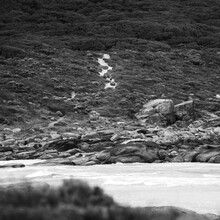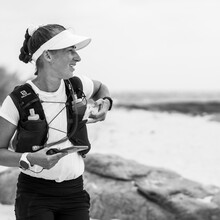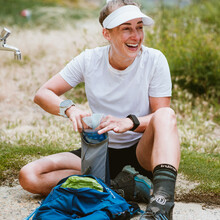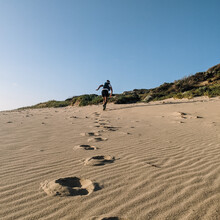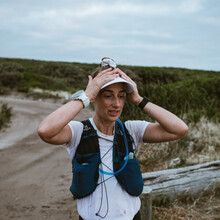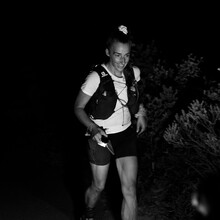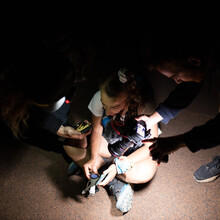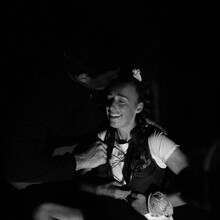I decided to do Western Australia's Cape to Cape trail after spending over 100 days in stage four lockdown in Victoria, followed by 2 weeks of home quarantine. Simply put lockdown was challenging to endure. Your usual sense of mobility was quashed as you were quarantined to a 5km radius around your home with a cap of 1 hour of outdoor exercise and an 8pm curfew. No shops were open and postage was massively stalled. I will always remember the challenge of trying to buy underwear for my toddler Harry as we began toilet training.
The moment you are out of a restrictive lockdown it is hard to explain what it was like to those who didn’t experience it. The wounds are still open but it is remarkable how quickly you adapt to your usual liberties.
What I will always remember was the emptiness that came from having your goals sidelined or cancelled. The loosening up of restrictions seemed far into the future as no deadline or parameters were shared. You had no idea how long you would be sitting in this blurry world and therefore you couldn’t make any plans. Many of your usual mechanisms for feeling a sense of purpose were taken away. It felt isolating whilst also feeling suffocating at times.
To the credit of Victorians, I was amazed how compliant people were. It was an instance where people understood that the actions of one person could impact an entire State (as well as the rest of the country).
Mid October we moved to Perth, a state that had very little exposure to covid-19. People huddled in groups, ran around in the sunshine... it was unnerving initially. I felt a hangover of guilt for leaving my Victorian friends behind. It didn’t take long before the weight lifted off my shoulders.
The South West Coast has been a place I have travelled to since I met Mark in 2017 after being booted off Survivor. We spent our first few nights together in a cabin in Yallingup, unromantically battling diarrhea and processing the experience.
It's a wild and remote part of the country. However, you are relatively close to a low-density population. Without too much thought I locked into the idea of running the entire trail, and started to do recce runs a month prior to December 9th. In an ideal world I would have done the run before December to have a greater chance of milder temperatures and less encounters with snakes, but I needed the additional time to train. After my first 25km recce run from Indijup beach to Cape Naturaliste Lighthouse I realised this would be a significant undertaking. The soft sand is relentless and uneven, the rocks are sharp and the elevation is minimal but deceptive.
I credit previous runners who have taken on this undertaking and many of them generously reached out to me with support and guidance. These included Andrew Bates, current FKT for male unsupported, who sent me through his splits, extensive knowledge of the trail and joined me on my final recce run. Michelle Hooper, current FKT for female self-supported, who warmly encouraged me to do the run. Claire O'Brien, a local runner, also lent me much of my gear that I used on the day as my gear didn't arrive - thank you Australia Post.
My goal was to keep it simple, feel extended and remind myself that for 24 hours I could do something on my own. This was something I haven't experienced before as I typically have a team mate or a support crew. Therefore, the week before, with Andrew and my husband’s encouragement, I decided to tackle this run unsupported versus self-supported. My overarching goal was to complete it in under a day.
My kit included:
- 5000 calories of Spring Energy - in liquid nutrition powder + gels
- iphone
- 2 x battery packs
- iphone cord
- suunto 9 baro & cord
- spare socks
- buff
- lightweight lululemon jacket
- spot tracker
- lip balm
- medical kit: snake bandage, 3 bandaids, fixomull, 4 panadol
- exposure headtorch*
- 1.5 litre salomon bladder
- 2 x 500ml salomon flasks
I started at 5am from Cape Leeuwin lighthouse, feeling plenty of nerves and competing thoughts in my mind. Darkness had lifted, winds were 30-40km/hr (SW) and clouds were in the sky.
Right out of the gate I took a wrong line up some unnecessarily jagged rocks with the trail 10 metres to my right on flat terrain. “Keep calm Sam, this is going to be a long day if you don’t remain in control”.
Focusing on keeping my breath in a smooth rhythm I got back on course and moved through the rocks and into the flowing single trail. Early into the run you get a solid 6-8kms of comfortable running terrain. This is not the norm.
I broke the course into 6 sections and crafted a spreadsheet of what I expected to be my slowest to quickest time. On paper it all looked manageable - probably why so many people give this trail a crack thinking the current times are easy. All I can say is get out on the course and experience it before you do your predictions.
By the time I got onto the first long beach section I was feeling relaxed and prepared for some very soft sand shuffling. To my surprise and delight the sand was firmer than during my recce run and the tailwind was very much in my favour. My average pace was well ahead of what I expected and I rolled my legs over singing to the nature gods “thank you”.
I had no issues tracking into Hamelin Bay where I planned to fill up my bladder for the first time. I am not typically a great drinker of fluids – yes, I know terrible for an endurance athlete. Every 5 minutes I made sure I had a solid drink – alternating between my two soft flasks up front (one with electrolytes and the other with water) and my bladder which had 220 calories of Spring Energy nutrition.
Finding taps to fill up your water isn’t challenging but they are not along the route. Therefore, the day before I physically clocked the taps at Hamelin Bay & Conto’s Campground. This gave me confidence over the first 40kms of the run that I didn’t have to worry about this. Andrew Bates also sent me google map images with markings with where the taps were. I am happy to pass this onto anyone who wants to tackle an unsupported run - send me a DM via instagram.
Andrew had reminded me how time expands the further into the run you get. Simple tasks such as taking off your pack, opening up your bladder, crouching down to fill up water, squeezing it back into your pack - become complicated. I spent no more than 3 minutes filling up water here. 28kms down I was back onto the beach and cusping the sand closest to the water. It was the most compact but it also means you have to watch out for an unexpected wave of water over your shoes. I had a few kms of relaxing off navigation knowing approx. 6kms in was the turn off the beach towards the Boranup Forest.
I found this exit hard to find during my recce run. There is a Cape-to-Cape sign in the dunes and the exit is up a short steep climb to the left of it. There was no running for me here and I know I looked very ungraceful getting on my hands to climb up it. I kept reminding myself that I have some flowy running coming up soon in the forest.
Approx. 35kms in I felt my first mental & physical block. I came into this run with a very short build up, off a pretty negligible endurance base. I knew there would be a point where my body would give up. The mind is powerful and I was planning to use it to my advantage to push beyond fatigue for as long as I could. But there are physical limitations that will reduce you to walking. Feeling the early signs of heavy legs, a touch earlier than I hopped, I slowed down to a walk, put in my headphones and had another gel. Within 10 minutes the discomfort subsided and I was moving with greater ease. With relief I felt satisfaction that I knocked over one of the many ‘walls’ I was likely to feel.
I loved running through the forest. With slightly cooler temps than I expected the kms moved by quickly. Walking the opposite direction were 20 school kids with large backpacks. I stopped to have a chat and photo with them. This was the only physical contact I had with someone all day.
You need to turn right, away from the trail, to go into Conto’s Campground to fill up your water. My husband, videographer, photographer and mate were here - as well as a couple of holiday makers who watched my fill up my water, add electrolytes and have a gel. This routine was the same at every water stop.
Back on the trail with 20kms to the Margaret River Mouth. This first 8km of this section is one of my favourite parts of the run. You run on a narrow single trail on the headlands with a magic view of the ocean. You are pretty exposed up here, but I was still appreciative for the south westerly. You have an unpleasant soft sand block during before going inland. These kms moved slowly but I did my best to keep jogging – consistency was the name of the game.
The fill up at Margaret River Mouth clocked over 69kms and was the first time I sat down all day. I struggled to press the tap hard enough to release the water so this was a slightly longer stop.
I was happily surprised that there was a break in the river to cross without getting my feet wet. I got off the beach and onto the grassy trail towards Gracetown. I had to be really dialed to my navigation in this section and I’m pretty sure I made a small error close to Gracetown. The trail changed in 2017, so make sure you don’t rely on google maps. I was following Andrew’s GPX file as well as referring to the cape to cape route on maps.me. There were two sections that really stumped me and I zig zagged all over the place trying to stay on course. Feeling flustered, my focus shifted away from the other fundamentals such as filling up my water and I didn’t refill in Gracetown thinking I was further along the route than I was.
This was a terrible error of my part - that had significant consequences for the remainder of the run.
Approx 6kms past Ellenbrook Homestead - with 1.5 hours of daylight remaining I pulled over at a tourist platform to grab my first caffeine gel for the day and to move my head torch into reach. I went into a state of panic as I couldn’t locate the head torch. I had either forgotten to pack it or it had fallen out of my pack. I tried to come to a conclusion which one it was, but reality is it didn’t matter. It was no longer there and I struggled to mentally work out how I was going to complete this run without borrowing a torch from Mark – making this no longer an unsupported run.
I had over 30kms to go and I knew a good portion of that would be in darkness. For anyone who knows the trail, it’s impossible to move or navigate without a light from Indiijup Beach to the finish – if not even earlier.
As I kept going through every pocket, willing my headtorch to magically appear, I decided my iPhone light was an alternate option. VASTLY inferior and increasing the degree of risk for me out on the course. I made the decision I would rather slow down my pace and complete unsupported than shift to supported.
The heaviness of my error weighed on me, and I was nervous about what was ahead. I was also very parched and incorrectly told myself that the water at the Moses Creek Carpark (toilet block) was not safe to drink. I moved forward with a dry mouth and the occasional murmur “I’m so parched”. Please note for future runners, this tap is fine to drink, it is just low to the ground and slow to refill. It’s also important to note how quickly your judgment becomes impaired once you are dehydrated.
I wanted to make the most of the remaining light but my legs were heavier and more significantly my guts were not cooperating. The lack of fluids was affecting everything – mind; legs and guts.
It was a slog for the next 6kms and then I was in complete darkness. Coinciding with darkness I found myself on all knees in the sand heaving up the remainder of liquid I had in my guts. With my head dangling I closed my eyes and remember thinking ‘it’s going to be a long haul out of here.’
I am always amazed how you can go from being in the foetal position to moving forward. It defies what you should be able to do physically, the mind is definitely the determining factor here.
I arrived at the entrance to Smith’s Beach in a bad way and saw Andrew and the guys. I know they must have been concerned but they didn’t verbalise it. I sat on a grated drain, filled up my water and had a big gulp as though I hadn’t drunk in years. As you would predict my stomach didn’t appreciate that and I heaved again, disgracefully vomiting to a quiet crowd.
After a few moments I trotted down to the beach, still holding my iphone light as my only source of light. My visibility was really poor. At one point I didn’t realise where the shore line was and a wave crashed over me. Although not ideal., wet feet were no near my main problem.
I made it into Yallingup beach and mentally clocked that I was on the final stretch The terrain here is technically very runnable, but I didn’t have it in me. I did my best to power walk/shuffle at a respectable pace. I hadn’t checked my time or pace for a long time and I didn’t care anymore. I just wanted to make it to the finish line safely.
I wouldn’t say the final 20 - 30kms were enjoyable, but I never contemplated pulling out. Holding the torch and being dialled to the navigation every step was draining but part of this unique experience. We can grow from our failures – but I promise you I will never forget my headtorch again (which happened to be on charge in our cottage in Margaret River).
I called Mark with 5kms to go and told him that I was very tired now. It was the only time he asked if I was going to finish and I responded “don’t be silly, of course I’m going to finish. I will crawl if I must”.
When I got to the lighthouse, I was delighted to give Mark a prolonged hug. It was the first time we had touched in 21 hours and it felt so good. They had a bottle of cold sparkling water and a bag of salt and vinegar chips waiting for me. The moment my gut had the relief of no movement it felt better.
Although I did this unsupported, I felt I had a team. I knew the guys (and many other people were following the spot tracker). The knowledge that other people want you to do well is powerful. It can carry you through the dark times and remind you that you can find a way to muster through even when shit hits the fan.
My summary on this experience
Nature was very kind to me and all of the challenges I faced were imposed by my own errors. I realise the safety net I’ve had by having a team in my past runs and adventure racers. Having a team can mitigate sloppiness and weaknesses. Being unsupported means you need to be on top of everything. Ideally you are strong in all areas, but at the least you are the jack of all trades. I love the Cape to Cape and despite its exposing and wild nature, it leaves you understanding more about yourself.
A note on my content team:
Although unsupported my husband Mark Wales, best mate Josh Lynott, videographer Nic Morley and photographer Adam Kenna were around documenting the journey. Given what Victorians have endured this year, I thought it may be powerful to share this story.
They made no physical contact, nor assisted me to fill up water or with directions.
Notes to future runners to beat this time:
+ regardless of the weather I recommend filling up at Hamelin Bay, Contos Campground, Margaret River Mouth, Gracetown & Yallingup. There are a couple of other spots but I haven’t tested out these taps personally. I believe my nutrition was solid but the lack of water impacted by gut and wouldn’t let me consume for the final few hours of the run.
+ definitely try and do a recce of the course if you are not confident with navigation aids. This has always been a weakness of mine; I have been known to get lost in a Coles carkpark. There are markers along the cape to cape but they are not always clear on and off the beaches and in some other sections along the route.
+ If I had my time again, I would start at 4:30am, just as it got light.
+ Navigation on your watch really churns through the battery. Even on “endurance mode” my battery was very low in the final 2 hours. I had to use my battery pack to keep it from going flat. It would be better to keep your watch on “performance mode” and have it on the battery pack from the beginning. I know others have entirely relied on maps.me for navigation via their phone, but ironically, I didn’t want to do that as I didn’t want to have my phone out.


